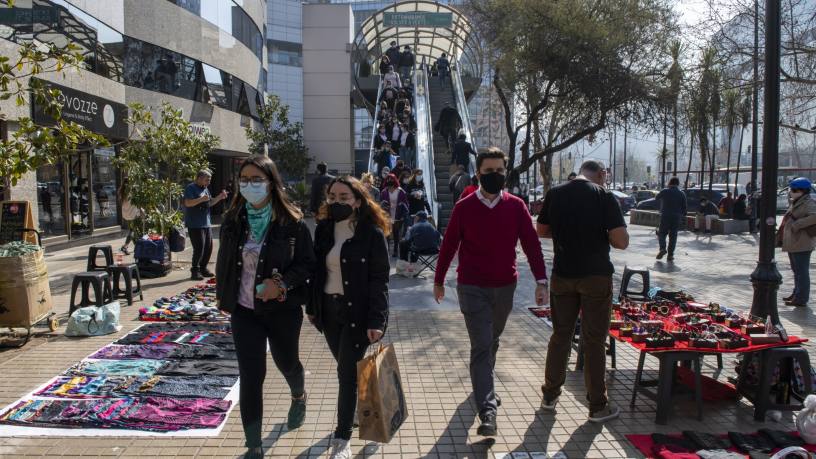Chile, once considered a country of stability in South America, has been going through economic and political change over the past few years — something that is not likely to stop anytime soon.
The upheaval began in October 2019, when mass protests against economic inequality began, lasting several weeks. It did not have time to get over the protests before the pandemic forced the government to implement lockdown policies, some of which will continue in one form or another for the foreseeable future.
While the economy will grow robustly this year, potentially inching into low double-digits, economic and political analysts say the only thing they are certain about is that 2022 will be rife with uncertainty as voters prepare to elect a new president and Congress in the final weeks of 2021, and then vote on a new constitution in 2022.
“Chile has been characterised as stable with its neoliberal model, but this has started to change. We are living through a moment in which we do not know what kind of government we will have, and what role the private and public sectors will have. Things could be much different [in the future],” says Lucas Serrano, director of the School of Public Administration at Chile’s Universidad San Sebastián.
Political questions
Chileans will go to the polls on November 21 to elect a new president. If none of the seven candidate receives 50% of the vote — which is a very strong possibility — the top-two finishers will meet in a runoff on December 19.
The most likely scenario is a left–right runoff that could add to the already strong polarisation in the country. The leader throughout the race has been congressman Gabriel Boric who, at 35, would become Chile’s youngest president if he succeeds. He heads Approve Dignity, a left-wing coalition of the Broad Front and Communist Party. While ahead, Mr Boric has not topped 30% in the polls.
The current president, Sebastián Piñera, is not allowed to stand for a consecutive four-year term, but his influence on the race might determine who ultimately wins.
In October, Mr Piñera, who has been highly unpopular for the past few years, got caught up in what might be the most serious problem of his presidency when his name surfaced in the Pandora Papers — a massive leak of around 12 million documents involving tax havens. He is one of three sitting Latin American presidents, with Dominican Republic’s Luis Abinader and Ecuador’s Guillermo Lasso, named in the document dump by the International Consortium of Investigative Journalists. Opposition parties on October 13 presented a motion that could lead to his impeachment before the end of his term in March.
Chile has been characterised as stable with its neoliberal model, but this has started to change
His political troubles have dragged down the candidacy of Sebastián Sichel, who served in his cabinet.
While Mr Sichel is not technically in the same party as Mr Piñera, he is widely considered his heir. Mr Sichel’s slide in the polls created space for José Antonio Kast, a former congressman who founded the far-right Republican Party. He ran in the 2017 election, receiving nearly 8% of the vote; however, he is closer to 20% this time.
Mr Serrano says that a runoff between Mr Boric and Mr Kast would be brutal and polarising, but could eventually end up being a moot point because of the discussions underway in the Constituent Assembly that was elected last May to rewrite the 1980 constitution. It was seated in July and has to finish its work by May 2022.
The new constitution would then be presented to Chileans in another referendum. The vote will be mandatory, unlike regular elections. This means that the new president will be elected under one constitution, but govern under a different one. The same goes for the 155 law-makers in the lower chamber of Congress and half of the 43-member Senate, who will also be chosen in November.
“Major changes could happen in the structure of the government. Some members of the assembly are talking about the next government as transitional, lasting only two years. In some ways, Chile is living through its own magical realism moment,” says Mr Serrano.
César Guzmán, macroeconomic manager in the research department at Grupo Security, an investment firm, says the uncertainty created by the elections and the discussions in the Constituent Assembly will keep investment at bay. “Private investors are more spectators than actors right now. I think it will be that way for some time until there is more clarity,” he adds.
Uneven growth
The political uncertainty will add to an already complicated economic scenario in 2022, when growth is forecast to slow considerably.
Chile’s economy is now projected to grow close to 10% in 2021, maybe even a little higher, according to some forecasts. The expansion this year is much stronger than was expected, with Chile recording the biggest upside growth in the second quarter in emerging markets, according to the World Bank. In September, S&P Global increased its projection this year for Chile to grow by 9%, up from 6.9%, while in October the International Monetary Fund increased its forecast from 6.2% to 11%. This would make Chile the fast-growing economy in South America this year.
Next year is going to be different, however, and potentially much different. In March, the World Bank forecast Chile to grow by 3.5% in 2022; it lowered that number to 2.4% in October. S&P Global estimates growth at 2.5%.
Inflationary pressures, like elsewhere in the region, were increasing faster than expected in the final quarter of the year and are forecast to remain high going into 2022. Inflation in September was much higher than projected, at 1.2%. That brought annualised inflation through September to 5.3%, well outside the central bank’s 2–4% target band. Rising inflation has also been accompanied by a weakening currency. The Chilean peso in October was at its weakest since the start of the pandemic.
Inflation in Chile is directly related to the energy sector. The country is one of the largest net importers of energy in the region, with 15% of all imports energy related. Global energy prices are rising and costs in Chile are rising with them. The West Texas Intermediate, the referential price for crude in the US, topped $80/barrel in mid-October, its highest level since the end of 2014. It is expected to remain high for the foreseeable future.
Also on the external front, but more positive for Chile, the country is benefitting from an increase in the international price of copper. Chile is the world’s largest copper producer and churned out 461,900 tonnes of the red metal in August. That was down 4.6% from a year earlier, but still more than double that of the world’s second producer, Peru. Copper exports account for 56% of Chile’s exports, up from around 40% of total export earnings at the start of the century.
Pandemic response
Mr Guzmán says growth in Chile is normally more dependent on external than internal factors, with expansion usually coming from improvements in the world economy. He adds that this is not the case today, with growth in 2021 the result of two anti-pandemic policies.
The first is the stimulus, with the Chilean state pumping a huge amount of resources into the economy to assist individuals and businesses alike. The government added nearly $27bn in emergency spending throughout 2021 to respond to the pandemic. According to analysis from Fitch Ratings, Chile’s cumulative Covid-19 fiscal response between March 2020 and June 2021 was equivalent to 14% of gross domestic product (GDP).
The stimulus is set to unwind in the 2022 budget, presented in September. The proposed budget is 22.5% below what was ultimately included in this year’s because of the health emergency. At $82bn, the 2022 budget aims to cut the deficit from 11.5% of GDP this year to 3.9% in 2022.
The bigger impact has come from the decision to allow Chileans to withdraw cash from their private pension funds (AFPs) as a way of confronting the pandemic. Chileans are approved for three separate withdrawals, and the prospect of a fourth was under discussion in the final quarter of 2021.
Chileans have withdrawn almost $50bn from their AFPs since July 2020. Each of the three withdrawals has allowed people to draw down 10% of their pension fund. The fourth withdrawal would also allow 10% to be taken from accounts. The withdrawals have contributed to inflation, but they are also a key driver in strong growth in 2021.
Elijah Oliveros-Rosen, senior economist for Latin America at S&P Global, says Chile’s economy expanded in the second quarter primarily because of spending, with purchase of durable goods growing by 12% that quarter. He adds that this has already started to change and will be more prevalent in 2022.
“We are going to see a significant slowdown in consumption in Chile, which expanded this year because of pension withdrawals. Growth was the result of consumption, not investment,” he says.
Also contributing to the slowdown next year are the moves by the Central Bank of Chile to increase the benchmark interest rate. The rate was increased in July and August, and by 125 basis points in October — the largest single increase in its history — bringing it to 2.75%. Additional rate hikes are expected in the coming months. S&P Global forecasts the benchmark rate at 3.5% for 2022. It was 0.50% when the central bank began raising it in July.
Mr Oliveros-Rosen says the political changes are also adding to the headwinds. He says that in addition to increased polarisation, which will happen regardless of who wins the election, there is the new constitution and investors will be looking at the fiscal implications of what will be included.
He adds, however, that Chile remains in a good position overall, with its debt/GDP ratio in check, allowing room for some changes. “Chile has a good war chest. The concern is if there is a period of low growth combined with higher fiscal spending. This would drag Chile down a different path. It is what people are watching,” says Mr Oliveros-Rosen.
Continue reading: Chilean banks brave tough environment













